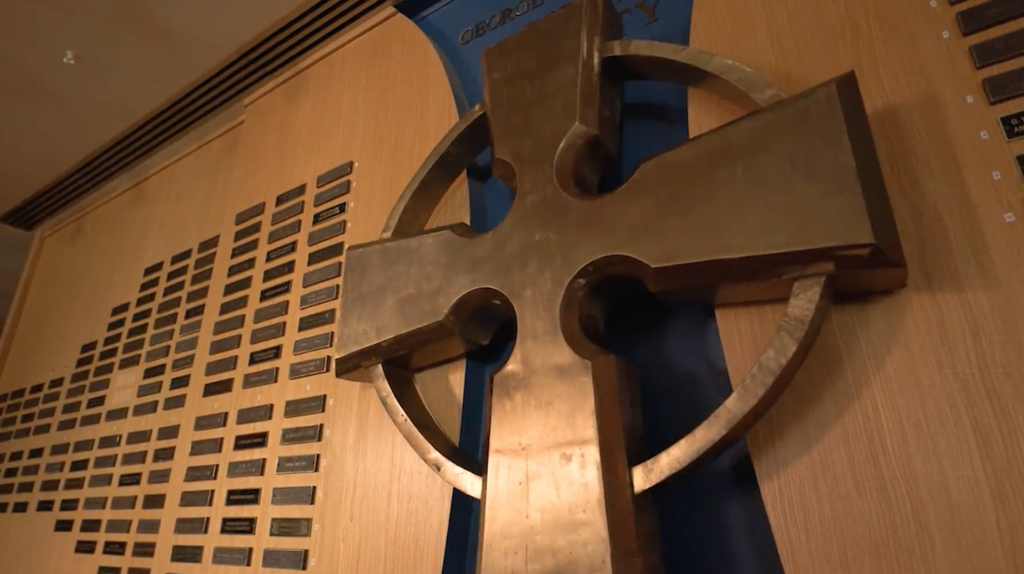Gifts Received, Gifts Shared

Emphasis on planned giving bolsters CDSP finances, donors’ sense of connection
By Sam Wallace
CDSP recently received three large planned gifts—one of them a complete surprise—totalling almost $1.5 million. Deborah Sham, the Rev. Dwight Edwards (‘54) and Rosie Edwards, and the Rev. Charles Sacquety (‘65) each named CDSP as a beneficiary in their wills.
The gifts include portions of estates, property, and life insurance policies. They occasioned seminary staff to reflect on the importance of planned gifts and the people who make them.
Deborah Sham
“I remember Deborah Sham very vividly,” said the Rev. Schaper, CDSP’s planned giving advisor. He met her years ago during a guest preaching engagement at St. James Episcopal Church in San Francisco while he was also serving as the gift planning officer for the Episcopal Diocese of California.
Caption: The Rev. Richard Schaper, a certified financial planner, serves as CDSP’s gift planning advisor. He advocates for pastors’ role in encouraging parishioners to prepare wills and remember personally meaningful causes and communities.
As part of Schaper’s visit to St. James, the parish offered the services of a volunteer estate planning attorney. Participants in the workshop who didn’t already have a will could get the assistance they needed to write one. Of course, Schaper encouraged them to remember their church as a part of that process.
Still, this gift came as a surprise to the school, as is sometimes the case with bequests.
“What she put in the will was between her and her attorney. No one knew,” Schaper said. When Sham died, the seminary learned she had left half of her estate to St. James and half to CDSP. According to Schaper, Sham was very fond of a priest who was a graduate of the school. “And so she remembered the seminary very well,” he said.
The Rev. Dwight Edwards
The Rev. Dwight Edwards’s planned gift was once a gift given to him.
As a seminarian, Edwards was assigned a field position with St. Mary’s by-the-Sea Episcopal Church in Pacific Grove, CA. Dwight and Rosie Edwards once explained to Schaper over coffee that a woman from Salinas offered her cottage for Edwards to live in while he was serving at St. Mary’s.
“That was a wonderful opportunity for him,” Schaper said. “Because otherwise, he had no place to live!”
Edwards continued to serve St. Mary’s as a priest after he was ordained, and the parishioner later gave him the cottage outright.
“I feel as if the church gave me this cottage,” Edwards told Schaper, “and I would like to return it to the benefit of the church when I die.”
The couple were also avid classical music fans. When Edwards died, his will specified that a quarter of this property was to go to the Carmel Bach Festival, a quarter to Bay Area public radio station KQED, a quarter to St. Mary’s, and a quarter to CDSP.
The Rev. Charles Sacquety Jr.
The largest of the three gifts came from the Rev. Charles Sacquety, who was also a significant giver to the seminary during his lifetime. In addition to leaving a portion of his home, he also designated CDSP as the beneficiary of three life insurance policies.
Interestingly, Sacquety’s life and ministry led in a fairly direct way to still another planned gift, from area Episcopalian Virginia (Ginnie) McCormick.
“When the seminary gave him an honorary doctorate, Ginnie was a member of St. Paul’s in Oakland and came to the seminary for that occasion,” Schaper said. “That’s how she connected with CDSP, and she grew to love it. She passed away two years ago. A majority of her estate went to CDSP—and it was because of her connection with Charles.”
The Gibbs Society
Generous though these particular planned gifts were, they are hardly anomalies. CDSP’s rich tradition of planned giving stretches back to its very founding. The planned estate gifts of George and Augusta Gibbs, for whom Gibbs Hall and the seminary’s planned giving society are named, were instrumental in CDSP’s beginnings.
Caption: The Gibbs Society Wall of Honor served as an appropriate backdrop for segments of CDSP’s 2021 online commencement exercises. | Video screen capture
“George was concerned because he noticed that when Episcopal churches in this part of the world sent seminarians back east to seminary, they would never come back to the West Coast,” said Schaper. “He said we needed a seminary in the West to train them here.” Gibbs offered his estate in San Mateo as a location for what would later become CDSP, and upon his death Augusta moved the seminary to a new building next to Grace Cathedral.

However, the Rev. Dr. Randal Gardner ‘84, donor and alumni relations associate, noted that planned gifts need not be extravagant.
“When the Gibbs Society was launched, I had almost nothing to share,” he said, “But when our son was born, we made a will. So what I designated for CDSP back then was my vestments and my books. My name is almost on the cross itself on the Gibbs Society Wall of Honor in Denniston Hall, despite my paltry offering at the time.”
In other words, planned gifts of any size are first and foremost an opportunity to acknowledge personally meaningful relationships to important communities. Gardner said he originally did so in the most appropriate way he could for the season of life in which he found himself.
Of course, as life circumstances change, so can donors’ giving plans. One way that many Episcopal clergy, including Sacquety, make planned gifts is through designating or re-designating the beneficiary of their church-provided life insurance policy. For many individuals, there comes a time later in life when an insurance payment would no longer be essential for funeral costs and family support.
“The policy was a benefit given to me at no cost,” wrote the Rev. Dr. Louis Weil to fellow clergy in 2018. “I have chosen to make CDSP the beneficiary. It is such an easy way to provide the seminary with a future $50,000. I am writing to you to encourage you to do the same!”
Editor’s note: Weil died in March following a brief illness.
Planting Seeds
Schaper and Gardner both emphasized the many theological dimensions of planned giving. For example, Gardner noted that the topic’s connection to death and dying can prompt conversations that are difficult but incredibly important.
“I encourage ministry leaders to meditate on dying as a way of being more present in the way that we care for those who have died and their families,” he said.
Similarly, Schaper regularly refers colleagues to an easily overlooked pastoral direction in the Book of Common Prayer (page 445):
The Minister of the Congregation is directed to instruct the people, from time to time, about the duty of Christian parents to make prudent provision for the well-being of their families, and of all persons to make wills, while they are in health, arranging for the disposal of their temporal goods, not neglecting, if they are able, to leave bequests for religious and charitable uses.
Still, perhaps the most enduring image to surface in recent conversations about planned giving at CDSP is the very biblical notion of planting seeds in anticipation of future growth that God will provide.
“These surprise gifts are from people who feel a bond with the school even though they might not have engaged with us in a personal way in ten, twenty, or even thirty years,” Gardner said.
In like fashion, today’s seeds may provide sustaining fruit in decades to come.
“When I was invited to speak to a planned giving conference being held at CDSP, I looked on the ground and gathered up seeds by the handful,” he said. “I passed them around, one to each participant, and said, ‘If you were to start a legacy society for your parish, it could be as tiny as this little seed to start with. But it will grow—you’ll be surprised how enormous it can become, and the difference that can make.’”

